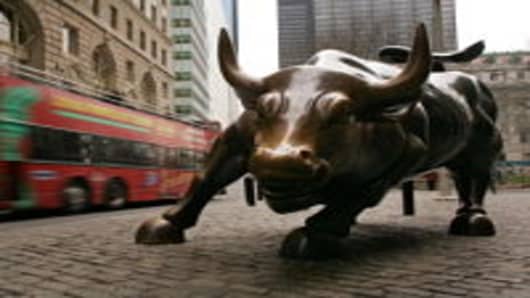The U.S. economy is faltering and Europe stands on the precipice of disaster. Yet someone forgot to share that news with investors, who this week bid up the S&P 500 Index to its highest peak in nearly four years.
In the midst of the euro zone's gloom and uneven readings on the U.S. economy, some Wall Street analysts remain surprisingly bullish on the outlook for stocks. Within the last week, a clutch of financial firms – including J.P. Morgan, Piper Jaffray and UBS AG – hopped on the bull-bandwagon with gusto.
To be certain, a few strategists are warning of about potential risks, especially with the jury still out on whether the Federal Reserve (learn more) and the European Central Bank (learn more) will unleash more quantitative easing to sate markets. For the moment, however, most feel content to follow the time-tested adage: “the trend is your friend.”
This week, irrepressibly bullish Goldman Sachs analyst Abby Joseph Cohen said the sight of the S&P 500 testing levels above 1400 seemed “a little spooky.” However, she added that based on valuations, the index could actually be cheap when compared to pre 2008 financial crisis, and the dot-com bubble of the late 1990s.
“It's really the valuation that matters, not just the price,” Cohen said. Price-earnings ratios of S&P 500 companies “are running 14 times earnings, as opposed to 25 to 26 times earnings in some of those previous periods.”
Caught up in what some have called the most hated rally in financial history, analysts such as those at Standard & Poors/Capital IQ – which revised its S&P 500 year-end forecast upward to 1500 – are expecting even more gains. (Read more: "Most Hated Stock Market Rally Has Won Non-Believers")
Piper Jaffray’s predictions are even more aggressive, with analyst Craig Johnson seeing the index jumping to 1550 within six months. By 2014, the firm sees the S&P at a gravity-defying 2000.
Along with other frothy stock prices, the S&P appears caught in a wave of investor anticipation over fresh rounds of central bank stimulus.
Doubts persist about whether the Fed will pull the trigger on QE3 (learn more). Yet Europe is widely expected to join in the liquidity party as early as next month, if reports of ECB bond-buying are to be believed. (Read more: "ECB May Set Bond Yield Target, but Keep It Quiet")
Given the mixed run of U.S. data and the overhang of Europe, conventional wisdom suggests investors should be more bearish. In an especially eyebrow-raising development, the S&P is even managing to outpace the returns of most hedge funds. (Read more: "Smart Money Looks Less Bright as Hedge Funds Lag S&P")
Last week, Tom Lee, chief U.S. equity strategist at J.P. Morgan, raised his target on the S&P to 1475 in the near-term. In his view, the S&P is being held aloft by improving economic momentum in the housing sector, and the fact that some investors may not be spotting the silver lining in the clouds.
"Fund managers are still too bearish," Lee said. "We think there's going to be a big chase into Election Day....we think it's a build-up."



